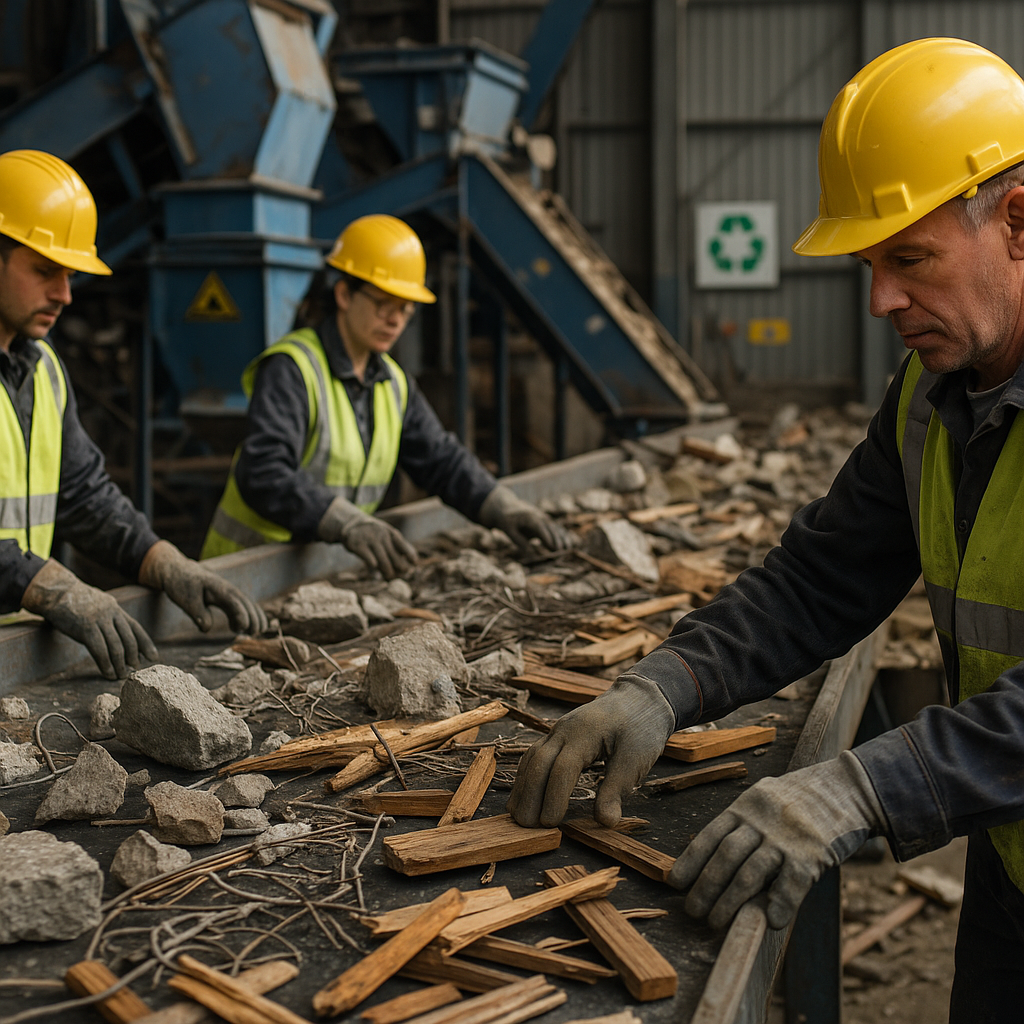5901 Botham Jean Blvd, Dallas, TX 75215
What Happens to Recycled Construction Materials?
July 9, 2025The construction industry produces more waste than any other sector globally, accounting for about one-third of global waste and over 40% of carbon dioxide emissions. This considerable volume underscores the significance of recycling construction materials to promote sustainable building practices.
When buildings are demolished or renovated, materials like concrete, wood, steel, and drywall embark on a transformative journey instead of ending up in landfills. The process begins with meticulous deconstruction and sorting at the demolition site, where materials are separated by type and quality.
Construction waste is then processed at specialized recycling facilities. Concrete is crushed into different-sized aggregates. Metals are sorted, cleaned, and melted down, while wood is processed into new lumber or wood chips. Each material follows its recycling path before reentering the construction cycle as valuable resources.
How Are Different Construction Materials Recycled?

Construction waste contributes to nearly one-third of global landfill, reflecting missed opportunities for recycling and resource conservation. Each material has a specialized recycling process to turn potential waste into valuable resources. Understanding these processes aids construction firms in implementing effective waste management strategies.
Concrete Recycling
Concrete is one of the most abundant construction materials and, fortunately, one of the most recyclable. The recycling process starts with crushing demolished concrete into smaller pieces. Large machines break down concrete chunks, removing embedded materials like rebar and wire mesh. The crushed concrete is then sorted by size through screens.
This recycled concrete aggregate is used in new construction projects as a base layer for roads, backfill for drainage projects, and even as an ingredient in new concrete mixtures. Using recycled concrete can reduce the carbon footprint of construction projects by up to 50% compared to using virgin materials.
Wood Repurposing
Wood waste from construction sites can follow various recycling paths. Clean, untreated lumber is often repurposed in new building projects or manufactured into engineered wood products, like furniture components, flooring, and structural elements. Wood unsuitable for direct reuse is processed into wood chips.
These chips become raw material for mulch, animal bedding, or biomass fuel. Some wood waste is also used in making particleboard and other composite materials. Wood recycling significantly reduces landfill volume while decreasing demand for new timber.
Metal Recycling
Metals have high recycling value in construction waste. The process begins with sorting different metal types. Steel, aluminum, copper, and brass are separated for individual processing. Magnets easily remove ferrous metals like steel from mixed materials.
Once sorted, metals are shredded and melted in furnaces. The molten metal is then formed into ingots or sheets for new products. Metal recycling is highly efficient, as steel and aluminum can be recycled repeatedly without quality loss. Recycling aluminum uses only 5% of the energy required to produce new aluminum.
Asphalt Recovery
Asphalt recycling is one of the construction industry’s success stories. The process starts by grinding removed asphalt into small pieces. This reclaimed asphalt pavement (RAP) is mixed with new asphalt binder and aggregates to create fresh paving material.
Modern asphalt plants can incorporate up to 40% recycled content into new mixes without compromising performance. This process significantly reduces the need for virgin petroleum products. Nearly 80% of all asphalt removed from roads and parking lots is recycled, making it America’s most recycled material by volume.
Gypsum and Drywall Recycling
Drywall recycling starts by separating the paper backing from the gypsum core. The paper components are recycled through standard paper streams. The gypsum is processed to remove contaminants before being ground into powder.
This recycled gypsum powder is an ingredient in new drywall manufacturing and serves as a valuable soil amendment in agriculture, helping to improve soil structure and add calcium and sulfur. Recycling one ton of drywall saves more than a quarter-ton of virgin gypsum from being mined.
| Material | Recycling Rate (%) |
| Concrete | 98 |
| Wood | 20-30 |
| Steel | 82 |
| Asphalt | 80 |
Brick and Masonry Recycling
Bricks and masonry undergo a similar crushing process to concrete. Clean bricks in good condition are often reused in new construction, valued for their aesthetics in architectural projects. Crushed brick serves as aggregate material in concrete production, drainage applications, and landscape fill.
Brick recycling reduces landfill volume and conserves the energy that would otherwise be spent firing new bricks. The distinctive appearance of reclaimed brick is increasingly valued in modern designs, adding character while supporting sustainability goals.
Glass Recovery
Construction glass requires careful recycling. Uncontaminated window glass is crushed and melted to produce new glass products. When mixed with other materials or containing treatments, glass can be crushed and used as aggregate in concrete or as a component in fiberglass insulation.
Glass cullet (crushed glass) can replace up to 95% of raw materials used in new glass manufacturing. This greatly reduces energy consumption, as melting cullet requires lower temperatures than raw materials.
Recycling construction materials presents a crucial opportunity to reduce environmental impact while creating economic value. By diverting these materials from landfills and processing them for reuse, the construction industry can make significant progress toward sustainability. Each material’s recycling process highlights the innovation and specialized approaches needed to maximize resource recovery and minimize waste.
What Are the Benefits of Using Recycled Construction Materials?
Using recycled construction materials offers significant environmental and economic advantages for builders, developers, and the planet. Since the construction industry generates about one-third of global waste, choosing sustainable materials is crucial for reducing environmental impact.
Recycled construction materials help shift the building sector towards a circular economy. By reusing materials that might otherwise become waste, construction projects can substantially reduce waste while conserving valuable natural resources. Here are the key benefits.
Environmental Benefits
The environmental advantages of using recycled construction materials are extensive. Primarily, these materials keep substantial waste out of landfills. Construction and demolition waste accounts for around 40% of landfill content in many areas, so using recycled materials directly addresses this concern.
Moreover, using recycled materials significantly lowers the carbon footprint of construction projects. Producing new materials like cement, steel, and wood demands extensive energy for extraction, processing, and transport, whereas recycled materials bypass much of this energy-intensive process. For instance, using recycled steel requires about 75% less energy than producing new steel from raw materials.
Resource conservation is another critical benefit. By reusing materials like reclaimed wood, recycled concrete aggregate, and repurposed metal, construction projects reduce the demand for virgin resources, helping preserve forests, minimize mining impacts, and protect ecosystems from further degradation.
Cost Savings
Beyond environmental benefits, recycled construction materials often provide significant cost benefits. Recycled materials generally cost less than their new counterparts. For example, reclaimed lumber can be 25-50% more affordable than new wood of similar quality. Likewise, recycled concrete aggregate typically costs significantly less than newly quarried stone.
Projects using recycled materials also reduce waste disposal costs. Construction waste disposal fees continue to rise as landfill space diminishes, making recycling and reusing materials a cost-effective choice. Some contractors report saving thousands of dollars on medium to large projects through efficient recycling programs.
Transportation costs may also drop when using locally sourced recycled materials, reducing fuel consumption and related expenses while supporting regional recycling businesses.
[[artifact_table]] Comparison of Environmental Impact: Recycled vs. Virgin Construction Materials [[/artifact_table]]Green Building Certification Benefits
Using recycled construction materials can help projects qualify for esteemed green building certifications. The Leadership in Energy and Environmental Design (LEED) program awards points for using recycled content materials, reducing construction waste, and sourcing locally. These points contribute towards achieving different LEED certification levels—from Certified to Platinum—enhancing the project’s marketability and value.
Other certification programs like BREEAM, Green Globes, and Living Building Challenge similarly reward the use of recycled materials. Projects with these certifications often command premium prices and attract environmentally conscious tenants and buyers.
Beyond formal certifications, using recycled materials enhances a project’s sustainability narrative. Companies can emphasize these choices in marketing efforts to appeal to the growing number of consumers who value environmental responsibility.
Quality and Performance
Today’s recycled construction materials meet or exceed industry performance standards. Modern processing techniques ensure recycled materials maintain structural integrity and durability. For example, recycled steel performs identically to new steel, and recycled concrete aggregate can equal the strength ratings of virgin aggregate when properly processed.
Many recycled materials offer unique aesthetic qualities unattainable with new materials. Reclaimed wood, for instance, features distinctive patinas, grain patterns, and character marks from its previous use, adding visual interest and historical significance to new construction projects.
Recycled materials can also enhance building performance. For example, recycled content insulation materials often offer excellent thermal efficiency, helping reduce energy consumption throughout the building’s operational life.
What Challenges Are Associated with Recycling Construction Materials?

Recycling construction materials, while environmentally and economically beneficial, faces significant challenges. Contamination is one of the most persistent issues within the industry; even small amounts of non-recyclable items can make entire loads of recyclable waste unusable. This problem is particularly evident in mixed construction debris containing materials like drywall, insulation, and treated wood.
Another major hurdle is the concern over quality and performance. There is often skepticism about whether recycled materials can match the structural integrity and durability of new materials. Without proper testing and quality control, recycled materials may not gain the confidence of builders, architects, and clients who prioritize long-term performance and safety.
Logistical issues further complicate recycling efforts. Construction sites generate large volumes of diverse materials, making sorting and transportation challenging. Space limitations on many sites exacerbate this, as restricted room for material segregation and storage hinders effective on-site recycling. Transporting recyclable materials to the appropriate facilities can also be costly and time-consuming, discouraging contractors from focusing on recycling.
Innovative Solutions Emerging
Despite these challenges, effective solutions are being developed. Advanced sorting technologies are improving waste processing. AI-powered sorting systems identify and separate materials with high accuracy, addressing contamination issues. Mobile crushing and screening equipment allows for on-site processing of concrete and other materials, reducing transportation costs and emissions.
Digital material tracking solutions are addressing logistical and collaboration challenges. Cloud-based project management systems provide real-time updates on recycling targets, waste data, and available options. This transparency helps align all parties towards shared sustainability goals and enhances coordination between stakeholders.
Significant strides are also being made in quality control. Standardized testing protocols for recycled concrete aggregates now ensure they meet ASTM standards for structural use. Reclaimed steel retains the same strength as new steel when processed and certified properly, boosting confidence in recycled materials among professionals.
Building Stronger Industry Partnerships
Enhancing stakeholder collaboration is crucial for overcoming recycling challenges. Educational initiatives are vital in creating a recycling culture among participants. Training programs educate workers on the importance of proper waste sorting and the value of recycled materials in construction.
Some construction firms are setting clear recycling goals and incentives for participants, incorporating recycling performance into contracts, or offering rewards for exceeding targets. Regular stakeholder meetings focused on waste management provide forums for addressing challenges and sharing best practices.
In Seattle, a recent high-rise project exhibited the potential for efficient construction waste recycling. The team implemented a comprehensive waste management plan with on-site sorting, mobile recycling equipment, and partnerships with local facilities. Through collaboration, they achieved an impressive 95% waste diversion rate, proving that with proper planning and coordination, these challenges can be overcome.
The construction industry is developing more sophisticated recycling approaches as sustainability becomes ever more important. Emerging technologies like blockchain for material tracking and robotics for waste sorting are set to further optimize recycling processes, bringing near-zero waste construction closer to reality.
[[artifact_table]]Challenges and Solutions in Construction Material Recycling[[/artifact_table]]Conclusion: The Future of Recycled Construction Materials

The construction industry is at a crucial stage in its shift toward sustainability. As environmental concerns grow and resources become scarcer, recycled construction materials are becoming increasingly important. Incorporating these materials into building practices is not just ecologically necessary; it is also a smart business strategy that blends innovation with responsibility.
The future of construction will be shaped by circular economy principles, enabling materials to flow from one project to another in a continuous cycle of reuse. From reclaimed wood and recycled steel to innovative eco-bricks and green concrete made from waste, these materials offer new possibilities for sustainable, high-performance buildings. Advances in material processing technology will continue to enhance the quality and versatility of recycled materials, making them increasingly competitive with new resources.
For your next construction or renovation project, consider the environmental and economic advantages of using recycled materials. Contact Okon Recycling at 214-717-4083 for expert advice on sourcing and implementing sustainable materials that will reduce your project’s environmental footprint while meeting your performance needs.
